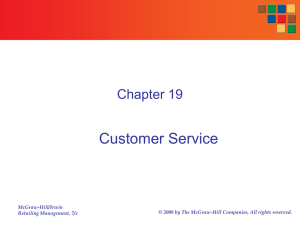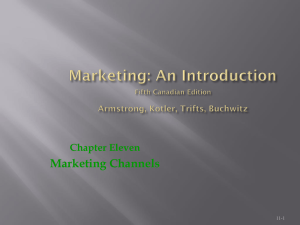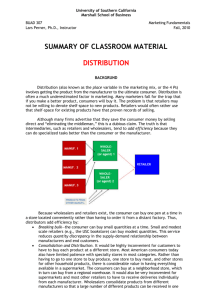Storewars Business Simulation - Category Management Association
advertisement
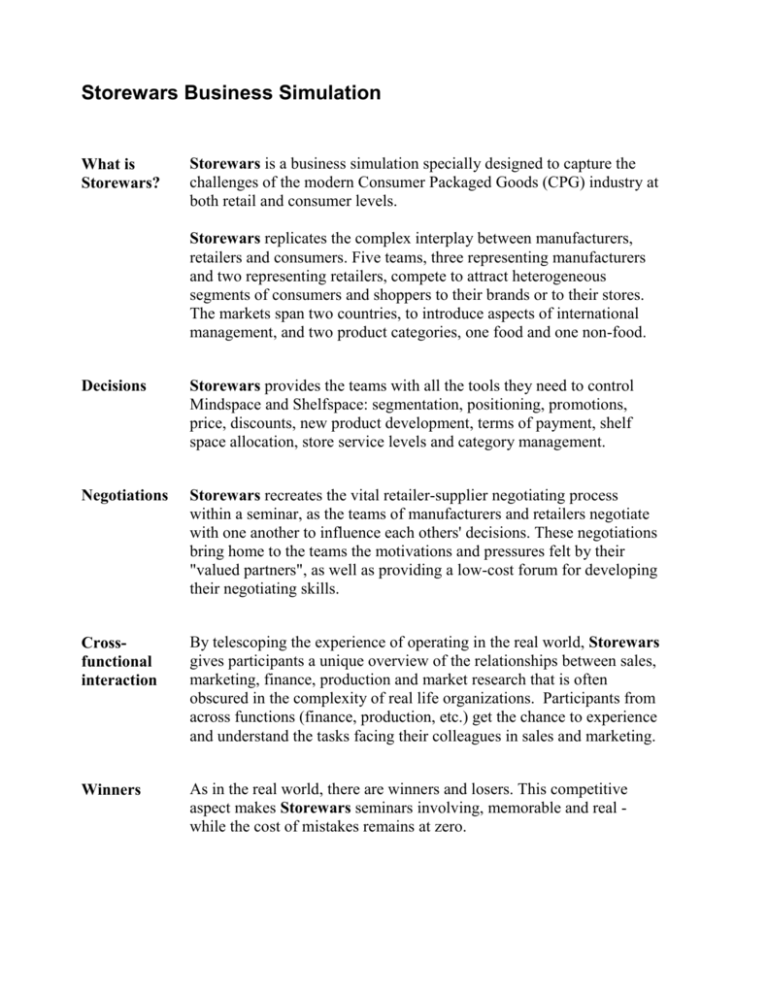
Storewars Business Simulation What is Storewars? Storewars is a business simulation specially designed to capture the challenges of the modern Consumer Packaged Goods (CPG) industry at both retail and consumer levels. Storewars replicates the complex interplay between manufacturers, retailers and consumers. Five teams, three representing manufacturers and two representing retailers, compete to attract heterogeneous segments of consumers and shoppers to their brands or to their stores. The markets span two countries, to introduce aspects of international management, and two product categories, one food and one non-food. Decisions Storewars provides the teams with all the tools they need to control Mindspace and Shelfspace: segmentation, positioning, promotions, price, discounts, new product development, terms of payment, shelf space allocation, store service levels and category management. Negotiations Storewars recreates the vital retailer-supplier negotiating process within a seminar, as the teams of manufacturers and retailers negotiate with one another to influence each others' decisions. These negotiations bring home to the teams the motivations and pressures felt by their "valued partners", as well as providing a low-cost forum for developing their negotiating skills. Crossfunctional interaction By telescoping the experience of operating in the real world, Storewars gives participants a unique overview of the relationships between sales, marketing, finance, production and market research that is often obscured in the complexity of real life organizations. Participants from across functions (finance, production, etc.) get the chance to experience and understand the tasks facing their colleagues in sales and marketing. Winners As in the real world, there are winners and losers. This competitive aspect makes Storewars seminars involving, memorable and real while the cost of mistakes remains at zero. Survive and Thrive in a Changing Environment Realism By replicating the complex interplay between manufacturers, retailers and consumers, Storewars provides managers with the training to help survive and thrive in a dynamically changing and increasingly competitive market environment. Retailers the world over are becoming larger, more concentrated and more sophisticated. Often operating in nearly saturated retail markets, they strive to apply the marketing concept to their industry, where location remains critical and managing price perception is an art form in itself. Retailers are waking to the value of consumer loyalty, or Mindspace, and the need to direct their resources to winning it for themselves, stepping between manufacturer and consumer to influence purchasing habits in their stores. As retailers re-invent marketing to serve their own needs, they cannot avoid causing turmoil in the marketing department of their suppliers the inventors of modern marketing - the major FMCG manufacturers. Battle for Mindspace and Shelfspace Increasingly, manufacturers and retailers seek to control the same scarce resources: Mindspace and Shelfspace. Cooperation or Partnerships are sought from a position of strength and affecting the balance of power has become a major aim of marketing strategy for both players. Pursue win-win strategies Storewars captures and explores the challenges facing the modern CPG industry, providing an understanding of the retail business among manufacturers and an understanding of their suppliers' business amongst retailers. Storewars identifies and explores areas where retailers and manufacturers can pursue win-win strategies and uncover and tackle some of the obstacles as they do so. And through the real time simulation of the retailer-supplier negotiation process, Storewars provides a singular opportunity to improve the process and content of negotiations between retailers and manufacturers. A Storewars Seminar in Practice Teams Storewars is played by five teams of approximately five executives each. Three of these teams represent manufacturers and two represent retailers. All five teams operate in two countries (Limburg and Oland) and over two product categories (Foodles and Woodles). Decisions Each "period", representing six months in the real world, each of the five teams makes a "decision". A manufacturer's decision includes how much to produce of each of their brands, their list prices for the retailers for the next period, their advertising budgets and the positioning for each brand and new product development projects. Retailers' decisions include how much of each brand to order from the manufacturers, allocation of Shelfspace, retail pricing, private label management, investment in store quality and advertising. These decisions are made for each of the two countries so that all teams face local/global issues. Continued on next page A Storewars Seminar in Practice, Continued Results The decisions of all five teams are entered into the Storewars computer program and the simulation is run. This generates the results for the period in terms of consumer shop choice and buying behavior. The administrator then prints out for each participant, the company report for their particular company and a copy of the market studies that have been ordered by their team. Information provided At the beginning of the game participants are given their company report for period 0, along with a complete set of the market studies. The company reports show the company's financial information such as profit and loss accounts and also contain a newsletter with information such as ingredient prices for the next period. The market studies show typical market research data such as brand awareness, consumer perceptions of the brands and stores, the size of the market segments, market shares by market segment (both brand and retail), share of shelf space, etc. Interaction Decision 1 is made without consultation between the teams. From Decision 2, time is allocated for negotiations between the manufacturer and retailer teams. The manufacturers can offer many different incentives to the retailers to stock and promote their products. These include investing to create consumer demand, new products, offering discounts, promotional support and cooperative advertising. For all the teams, retailer or manufacturer, success in the game implies managing both consumer demand and retailer-supplier relations. Format, Content, Participants Duration The ideal Storewars seminar consists of four decisions spread over four days. It is generally more fruitful to allow participants adequate time to make decisions rather than try to do too many. The complexity is inevitable in a game designed to challenge experienced and senior executives. Thus time has to be allocated for an extensive introduction at the start. It is also beneficial to allow time for reflection and conclusions at the end. For experienced executives, a four-day seminar works very well. Lectures During a seminar, participants learn as they plan and play, but there are also more formal mechanisms for bringing out different aspects of the simulation. Firstly, this is achieved through lecture/discussions on related topics. Typical subjects for lectures include: Manufacturer Strategy Retailer Strategy Negotiations Global Retail Trends It is also possible, and often useful, to incorporate other activities and speakers within a Storewars seminar. Feedback sessions The other main tool for guiding participants to play at a higher level is the feedback sessions. Feedback sessions take place after a decision has been processed, just before the participants receive their results. The administrator shows the participants what decisions are being made, how the markets are evolving and what the financial impact has been. The administrator can also use these Feedback sessions to discuss the many other relevant issues brought up by the simulation: retail pricing strategy, shelf space allocation, roles of own label, promotions etc. Continued on next page Format, Content, Participants, Continued Number of participants The ideal number of participants is 29. This gives three manufacturer teams of 5 people and two retail teams of 7 people. We recommend slightly larger retailer teams because retailers have relatively more complex decisions to make. To operate five competitive teams, we recommend a minimum of 22 participants. This gives 4-person teams for the three “manufacturers” and 5-person teams for the two “retailers” (3x4 +2x5). At the other extreme, Storewars can support a maximum of 34 participants: 6 per manufacturer, 8 per retailer. Participants and use Storewars was developed by Marcel Corstjens, Professor of Marketing at Insead, France. It has been designed to challenge and stimulate executives up to the highest levels in the CPG industry. Storewars is relevant to both retailers and manufacturers, and seminars can involve them separately or together. As a shared activity between supplier and retailer, Storewars becomes a forum for discussing and understanding each other's position and problems, within a hypothetical and cost free environment. Internationally, Storewars has been received enthusiastically in Asia, Africa and America (North and South) as well as throughout Europe. Sample Agenda for a 4-Day Storewars Program with 4 Decisions Day 1 Introduction to the Storewars world Morning Day 2 Lecture – discussion Manufacturers’ and Retailers’ strategies Teams break out to prepare decision 1 Results and feedback from decision 1 Teams break out to prepare decision 1 continued Briefing for the negotiations Day 3 Lectures –special topic and Negotiation discussion Results and feedback from decision 2 Day 4 Results and feedback from decision 3 Teams negotiate and make decision 4 Teams break out to prepare decision 3 Lecture – learning objectives discussion Decisions for period 1 Teams break out to returned to administrator prepare negotiations Teams make decision 3 Final results, conclusion and winners celebration Evening activity/free time Evening activity/free time Afternoon After dinner Teams negotiate and make decision 2
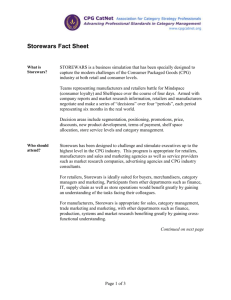





![[DATE] Mary Ziegler Director Division of Regulations, Legislation](http://s3.studylib.net/store/data/007212021_1-b96b03cd98cadfc74a22865c0247494d-300x300.png)


